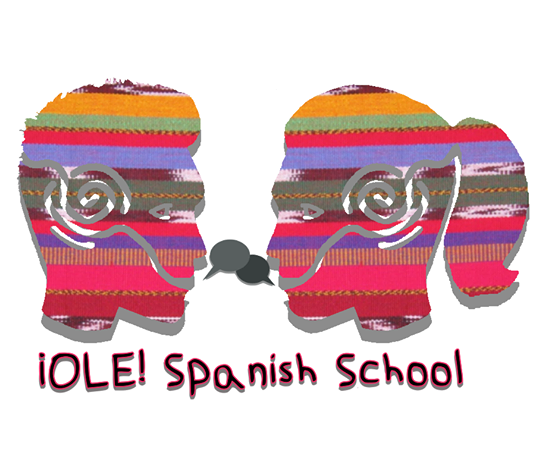Unit 1 – Lesson 1
The verb Ser: “To be permanently” or to tell time.
Ser is the most commonly used verb in Spanish. It is one of two forms of the verb to be in Spanish along with Estar and is used to describe permanent characteristics along with telling time.
!Ojo! Subject pronouns are pronouns used in Spanish to identify subjects of sentences. The following are the major subject pronouns used in Spanish and their English language equivalents. 1st Person Yo= I; Second Person Tu= You (Informal); Third Person El/Ella/Usted = He/She/ You (Formal); Ist Person Plural Nosotros= We; 3rd Person Plural Ellos/Ellas/Ustedes= They/They (female)/you all. Example:
1st Person: Yo 1st Person Plural: Nosotros
2nd Person: Tu
3rd Person: El/Ella/Usted 3rd Person Plural: Ellos/Ellas/Ustedes
Conjugation
Ser-to be (permanently)
Yo: Soy Nosotros: Somos
Tu: Eres
El/Ella/Usted:Es Ellos/Ellas/Ustedes: Son
The Verb Ser In Conversational Dialogue: Getting to know someone at school. Read and repeat out loud
Hola yo soy Deana. Hola Deana yo soy de Johnny.
¿De donde eres Johnny? Soy de
I am Deana. Hi Deana I am Johnny. Where are you from Johhny. I am from Naperville. And
Naperville. ¿Y tu? Soy de Glen Ellyn, con mucho gusto. Con mucho gusto Deana, eres
you? I am from Glen Ellyn, pleased to meet you. It’s a pleasure Deana, you are very
muy bonita. Aye, por favor no es cierto. Si es cierto, eres hermosa. Johnny, ¿creo que
pretty. Oh, please its not true. Yes, its true you are beautiful Deana. Johnny, I think you
eres amigo de David verdad, el tipo alto? Si, David es mi amigo, el es de Naperville tambien
are friends with David right, the tall guy? Yes, David is my friend, he is from Naperville too.
Chido, David es el amigo de mi mejor amiga Elena. A que hora es tu proxima clase
Cool, David is the friend of my best friend Elena. What time is you next class Deana?
Deana? Tengo una clase ahorita a las 1:30, es mi clase de espanol, lo siento pero
I have a class right now at 1:30, its my Spanish class, sorry but I have to go. Ok, I hope to
debo irme. Bueno, espero verte de nuevo pronto Deana . Yo tambien
see you soon Deana. Me too
Descriptive Adjectives
Due to the fact that ser is the verb used to describe permanent or nearly permanent characteristics as seen above. Here are some examples important descriptive adjectives and their opposites:
Grande- Large
Pequeno- Small
Largo- Long
Corto (length)- Long
Alto- Tall
Bajo- Short
Fuerte- Strong
Debil- Weak
Flaco- Skinny
Gordo- Fat
Bonita-Pretty
Feo- Ugly
Rapido- Fast
Lento- Slow
Limpio- Clean
Sucio- Dirty
Telling Time with Ser
Es la una: It’s one o’clock
Es la una con cinco: It’s one o’ five
Son las seite y cuarto: It’s 7:15
Son las seite con veinte cinco: It’s seven twenty five
Son las cinco y media: It’s five thirty
Son la cuatro con treinta y cinco: It’s four thirty five
Son las diez menos cuarto: Its 9 forty five (note: in Spanish literally “its 10 minus a quarter”)
? Que hora son? Son las doce y pico. Que hora es tu clase de espanol ? Mi clase de espanol es a las 5.
What time is it? It’s a few minutes after twelve. What time is your Spanish class? My Spanish class is at
five o’ clock.
Unit 1 – Lesson 2
The verb Estar: “To be” for emotions or locations
Estar is the second most common verb in Spanish after Ser. Used to talk about emotions or locations it commonly used with interrogatives such as “¿Como estas?” or “How are you?” or “¿Donde esta ella?” or “Where is she” in English.
!OJO! Remember Subject Pronouns from Lesson 1:
1st Person: Yo 1st Person Plural: Nosotros
2nd Person: Tu
3rd Person: El/Ella/Usted 3rd Person: Ellos/Ellas/Ustedes
Conjugation
Estar-to be (temporarily and in locations
Yo: Estoy Nosotros: Estamos
Tu: Estás
El/Ella/Usted: Está Ellos/Ellas/Ustedes: Están
The Verb Estar in Conversation: How are you? Where are you at? At work.
Read and repeat out loud
Hola Marta
¿Cómo estás hoy? Bastante bien Cristobal, ¿Que tal? Oye ¿Quién es la
Hello, Martha. How are you today? Pretty well Cristobal, whats up? Who is the new
nueva empleada Marta? Ella es Elena, es de Mexico. ¿Donde esta su oficina? Está al
employee Martha? She is Elena. Elena is from Mexico. Where is her office? It’s next to
lado de tu oficina Cristobal. Oh mira alli viene. Hola Marta. Hola Elena ¿Y usted cómo se
your office Cristobal. Oh look here she comes. Hi Martha. Hi Elena. And what is your
llama? Me llamo Cristobal con mucho gusto mi oficina está al lado de la tuya.
name? My name is Cristobal, it’s a pleasure, my office is next to yours. Super, do you like
Orale ¿Te gusta trabajar aqui? Siempre hay mucho trabajo y no me gusta mucho el
working here? There is always a lot of work and I dont care for the manager but yes I like it.
gerente pero me gusta. Al hablar del rey de Roma mira quien asoma—- Cristobal y Elena
Speak of the devil! Ok, Cristobal and Elena, we’ll talk more in a bit, here comes the
hablamos mas a rato, alli viene el gerente!
manager.
As mentioned above “Estar” is frequently used to express our emotions, below are some basic emotions in Spanish:
Spanish Emotions
Bien- Well
Mal-Bad
Feliz- Happy
Triste- Sad
Enojado- Angry
Enfermo- Sick
Emocionado-Excited
Cansado-Tired
Confundido-Confused
Harto- Feed up
Nervioso- Nervious
Tranquilo-Calm
Preocupado- Worried
As well as shown in the conversation above “Estar” is often used with prepositions that bind subjects of sentences with objects when talking about locations. Below are some common prepositions:
Cerca de- Near (to)
Lejos de- Far from
Al lado de- Next to
A la derecha- On the right
A la izquierda- On the left
En medio de- In the middle of
Delante de- In front of
Detras de- Behind
